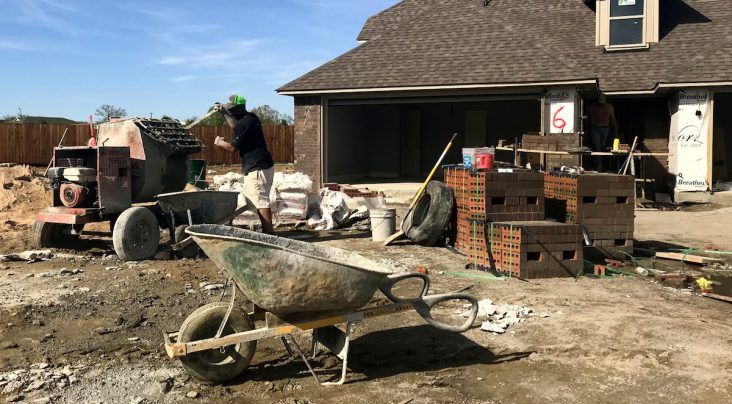Home builders share industry concerns with Sen. Boozman
by April 12, 2022 7:18 pm 1,881 views

Residential construction work at Chaffee Crossing in east Fort Smith.
Fort Smith-based home builders on Tuesday (April 12) discussed concerns they face in the industry, ranging from rising costs to a shrinking labor pool, with U.S. Sen. John Boozman, R-Ark., with “lumber oligarchs” part of the focus.
The meeting was an informal roundtable discussion hosted by the Fort Chaffee Redevelopment Authority.
“Demand for housing in the Fort Smith area is higher than it’s ever been,” said Rocky Walker, a builder, broker and Realtor with Cobblestone Homes and a member of the Greater Fort Smith Association of Home Builders (GFSAHB) board of directors. “We’re trying to keep up, but we’re fighting higher base costs and limited availability. It seems everyday to be something new.”
Walker said sales have increased 47% in the last two years for major lumber manufacturers, while their production has gone up less than 2%.
“And they refuse to raise their production, and the refuse to meet with the National Association of Home Builders and at least come to the table,” Walker said, referring often to the big lumber companies as the “lumber oligarchs.”
While he noted that lumber costs have started to decline in the last week, Walker said it is because of other factors, not because they have raised production. Supply chain issues mean electrical components, wiring, windows and more are more and more difficult to acquire, the group said.
“I’ll have houses sit for a month waiting on windows,” said Justin Green, owner of Justin Green Custom Homes and director for GFSAHB board of directors.

“We need people who are masons and trim carpenters and framers. I think that is something we can do better at. Put an influence toward trades,” he said.
Fort Smith Public School’s Peak Innovation Center is helping produce more skilled workers in the area, but the group said they hope programs for artisan skilled trades would be included at the center. Stephanie Stipins, GFSAHB executive director, said there needs to be a change in attitude at the high school level regarding their apprenticeship program.
“There is a stigma to being a physical working person instead of going to college, so they don’t necessarily promote that,” Stipins said. “When it comes to the apprenticeship program we have for builders, it’s always for the child who doesn’t have another option. … We need to take that particular stigma away from being a skilled laborer.”
Though the focus at Peak now seems to be more on advanced manufacturing, healthcare and other economic sectors, Stipins said, there have been conversations to reintroduce trade programs at the schools and using space available at Peak for those programs.
“And then they can send them out into the community to work, and that establishes a relationship with them. That’s the best way to start because there are so many eyes on the facility at Peak, the community would take (notice). That’s what it’s going to take,” Stipins said.
While Cary Smallwood with Carrington Creek Homes noted that any changes pushed by Congress at this time will not show results for four or more years, Boozman said there are some things his office and Congress can help with now. One of those is to help more with pushing or incentivizing trade certifications.
“We need to concentrate on what can be done now,” Boozman said. “There are some good things happening now.”
